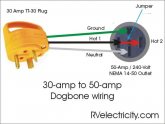I have a toyhauler which has a 5kw generator and a Magnum 1000 watt pure sine wave inverter, factory installed, for the residential refrigerator. I have replaced the two original lead / acid batteries with 6 AGMs, 100 ampHrs each. I am installing a Victron 712 smart battery monitor, 6 HQST 100 watt mono-crystalline solar panels on the roof and a Victron MPPT 150V / 60A smart solar controller.
What I have not purchased yet is a pure sine wave inverter capable of supplying the two 120 volt hot legs that supply all 50 amp RVs.
Also if it has been discussed much on this forum, I apologize for not finding it.
What I have not purchased yet is a pure sine wave inverter capable of supplying the two 120 volt hot legs that supply all 50 amp RVs.
Also if it has been discussed much on this forum, I apologize for not finding it.




